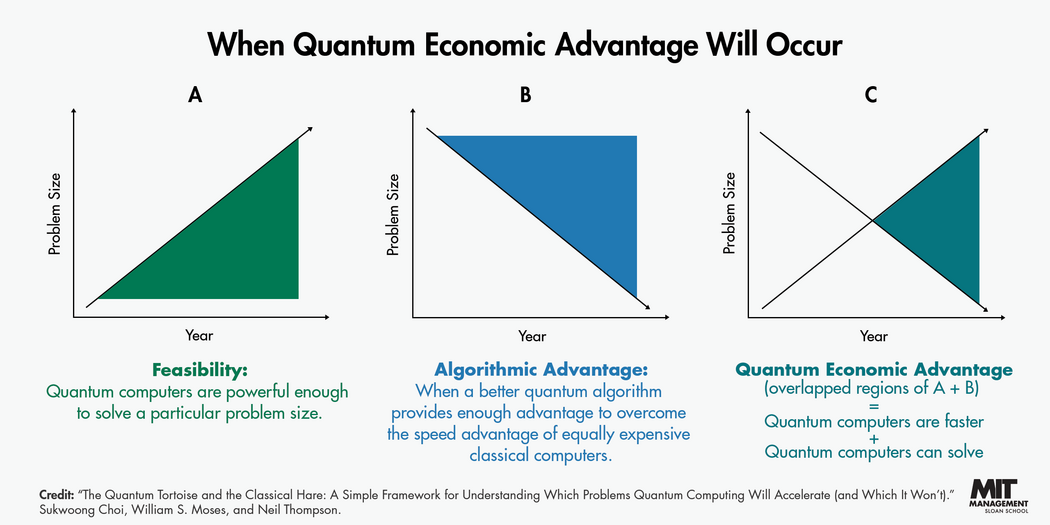Credit: Graham Carlow / IBM
Once-obscure technologies can manifest in no time, creating a scramble for companies to figure out how to effectively leverage them for competitive advantage.
Quantum computing, an innovation most can’t define and still don’t properly understand, might be the next obscure technology to have a seismic effect on business. Quantum computing applies the laws of quantum mechanics to simulate and solve complex problems that are too difficult for the current genre of classical computers.
In some cases, computers with these quantum abilities can solve large-scale problems much faster than their classical counterparts can. Examples include simulating the behavior of matter, analyzing compounds to create new drugs, optimizing factory floors or global supply chains, and identifying fraud and risk patterns in financial transactions, among others.
The current field of quantum computers isn’t quite ready for prime time: McKinsey has estimated that 5,000 quantum computers will be operational by 2030 but that the hardware and software necessary for handling the most complex problems won’t be available until 2035 or later. Yet organizations need to start thinking now about where they might leverage the technology to solve real-world business problems. Some companies already expect to invest more than $15 million annually on quantum computing, according to a November 2022 report.
A group of MIT researchers, in partnership with Accenture, has developed a framework to help tech-savvy executives start to evaluate the potential of quantum computing for problem-solving at their companies.
“Implicitly, there’s a race going on between the classical computer and quantum computer. For each type of question you want to solve, you want to know which type of computer will win so you can take the best advantage of it,” Neil Thompson, a research scientist at MIT Sloan and the MIT Computer Science and Artificial Intelligence Laboratory, said at the 2023 MIT Initiative on the Digital Economy annual conference.
Some companies already expect to invest more than $15 million annually on quantum computing.
Thompson is a co-author of “The Quantum Tortoise and the Classical Hare: A Simple Framework for Understanding Which Problems Quantum Computing Will Accelerate (and Which It Won’t),” along with Sukwoong Choi, an assistant professor at the University of Albany and a digital fellow at the MIT Initiative on the Digital Economy, and William S. Moses, an assistant professor at University of Illinois Urbana-Champaign.
“This framework provides a way to analyze the potential impact of switching to quantum computing before making the investment,” Thompson said.
The researchers’ takeaway is that small to moderate-sized problems, the most common types for typical businesses, will not benefit from quantum computing. Those trying to solve large problems with exponential algorithmic gains and those that need to process very large datasets, however, will derive advantages. “Quantum computing is not going to be better for everything, just for some things,” Thompson said.
An overview of quantum computing
The idea for building a system that leverages physics principles to simulate problems too difficult to model with traditional digital systems was first proposed in the 1980s. The concept was buttressed by MIT mathematician Peter Shor, who developed the first well-known quantum algorithm for breaking encryption in the 1990s.
Unlike today’s computers and supercomputers that use binary electrical signals to represent ones or zeros, quantum computers employ quantum bits (qubits), which are subatomic particles. When managed properly, qubits can represent combinations of both ones and zeros simultaneously. The more qubits, the greater potential for large-scale compute power for problem-solving.
When quantum will be useful
The crux of the framework in “The Quantum Tortoise and the Classical Hare” is the fact that classical computers (the hare) generally operate faster than quantum computers (the tortoise) but require more steps to accomplish a task — which the researchers liken to following an inefficient path from point A to point B.
With their ability to run more efficient algorithms, quantum computers have the potential to take a more direct path — but because they have slower processing speeds, it could actually take longer to solve the problem. The researchers’ framework aims to help businesses determine whether the shorter route or the faster computer is more valuable, depending on what problem they are trying to solve.
Scientists are striving to achieve quantum advantage, which is the ability to use quantum computers to solve problems that are beyond the reach of classical computers. (Some companies are estimated to reach the quantum advantage by 2030.)
But the researchers said the focus on quantum advantage overshadows the usefulness of quantum computers as they become cost-competitive with classical computers. To compensate, their framework establishes the benchmark of quantum economic advantage, which occurs when a particular problem can be solved more quickly with a quantum computer than with a comparably priced classical computer.
To determine the quantum economic advantage, business and technology leaders will have to consider two conditions:
- Feasibility, meaning whether a quantum computer exists that is sufficiently powerful to solve a particular problem.
- Algorithmic advantage, meaning that a quantum computer would be faster at completing a particular task compared with a comparably priced classical computer.
The overlap between the two is the quantum economic advantage. Thompson advised businesses to consider the speed of the computer versus the route. “Think of it like a race in getting from point A to point B, and the algorithm is the route,” Thompson said. “If the race is short, it might not be worth investing in better route planning. For it to be worth it, it has to be a longer race.”
Other things to consider about the current state of quantum computing
It’s still early days, but quantum is heating up. Quantum computing is early in the maturity cycle, but the landscape is heating up. IBM launched Osprey, a 433-qubit machine, last year and has set its sights on building a 100,000-qubit machine within 10 years. Google is targeting a million qubits by the end of the decade. Other players in the nascent space include D-Wave Systems, IonQ, Rigetti Computing, Honeywell, Microsoft, Intel, and PsiQuantum with some of the companies offering quantum computing services in the cloud. Fortune Business Insights has projected that the quantum computing market will grow from $928.8 million this year to $6.5 billion by 2030, a compound annual growth rate of 32.1%.
Related Articles
Development, cost, and talent challenges remain. Companies are still sorting out how to scale the number of physical qubits that can be built into quantum computing systems, as well as optimizing how the different qubits interact with one another as the horsepower scales. A lot of development work is currently devoted to decreasing the error rates, or the noise, in quantum computing. The technology is also expensive, given that the systems require intricate cooling technologies to shield the qubits.
The skills gap is another problem: Subject-matter experts are hard to come by outside of research and academic circles. McKinsey predicts that by 2025, fewer than half of quantum jobs will be filled, which is a major barrier to adoption.
Benefits will come on a continuum. Quantum computing becomes more attractive when the quantum algorithm is exponentially faster or significantly better than the classical computing option, or if the problem size being tackled is larger than the speed differential between the two. Given the current state of quantum technology, it will be useful sooner for small-scale problems whose solutions offer smaller benefits and will only later be viable for solving more complex problems that promise larger benefits.
Read next: how to build a technology road map in established organizations




